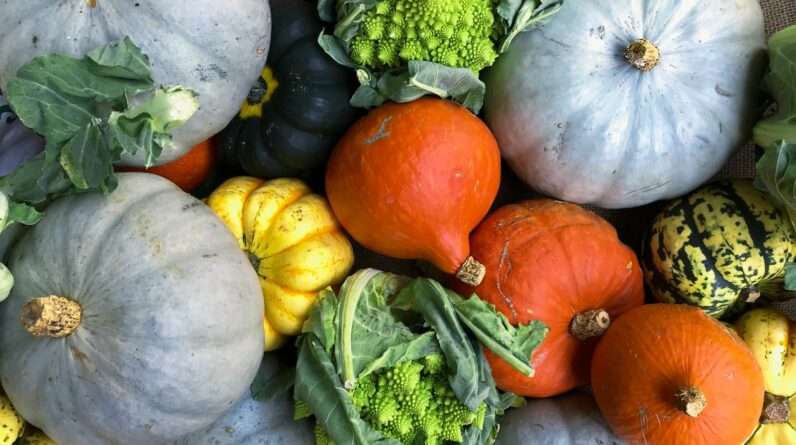
Imagine yourself surrounded by the vibrant hues of autumn, as you revel in the abundant harvest from your own vegetable garden.
With the right tips and techniques, you can transform your backyard into a bountiful oasis of fresh, flavorful produce.
From selecting the perfect vegetables to preparing the soil and caring for your plants, this article will guide you towards a successful autumn vegetable garden.
Get ready to embrace the season and reap the rewards of your hard work and dedication.
Key Takeaways
- Select vegetables that thrive in cooler temperatures and shorter daylight hours
- Prepare the soil by conducting a nutrient analysis, removing weeds and debris, and adding organic matter
- Use planting techniques such as proper spacing, companion planting, and organic pest control methods
- Care for your autumn vegetables by implementing integrated pest management, regular inspection, watering, and fertilizing
Selecting the Right Vegetables for Autumn Planting
You should consider which vegetables to plant for autumn by researching the best options for your region and climate.
When it comes to selecting the best vegetables for autumn planting, there are a few key factors to consider. First, choose vegetables that thrive in cooler temperatures and shorter daylight hours. Some of the best vegetables for autumn planting include leafy greens like kale, spinach, and lettuce, as well as root vegetables like carrots, radishes, and beets.
It's important to avoid common mistakes in autumn planting, such as planting vegetables that require a longer growing season or neglecting to provide adequate protection from frost.
Preparing the Soil for a Successful Harvest
Make sure to till the soil thoroughly before planting your vegetables to ensure a successful harvest. Proper soil preparation is crucial for the growth and development of your plants. Here are some important soil preparation techniques to consider:
- Conduct a soil nutrient analysis: Before planting, it's essential to evaluate the nutrient content of your soil. This analysis will help you understand which nutrients are lacking and allow you to make informed decisions about fertilization.
- Remove weeds and debris: Clearing the area of weeds and debris is necessary to prevent competition for nutrients and space. Use a garden hoe or tiller to remove any unwanted vegetation.
- Add organic matter: Incorporating organic matter, such as compost or well-rotted manure, improves soil structure, drainage, and nutrient availability. Spread a layer of organic matter over the soil and mix it in thoroughly.
- Break up compacted soil: Compacted soil restricts root growth and hampers water infiltration. Use a tiller or garden fork to break up compacted areas, ensuring better root penetration and nutrient absorption.
- Level the soil: A level surface helps with irrigation and prevents water runoff. Use a rake to level the soil, removing any large clumps or rocks.
Planting Techniques for Optimal Growth and Yield
To achieve optimal growth and yield in your vegetable garden, consider spacing your plants at least six inches apart to allow for adequate air circulation and root development. This is especially important when it comes to companion planting, as certain plants benefit from being grown together while others may compete for resources. By providing enough space between plants, you ensure that each one has enough room to spread its roots and access nutrients and water efficiently.
In addition to proper spacing, implementing organic pest control methods can further enhance the health and productivity of your garden. This includes using natural predators, such as ladybugs or praying mantises, to control pests, as well as practicing crop rotation and intercropping to disrupt pest life cycles and deter infestations. By following these planting techniques and incorporating organic pest control methods, you can create an environment that fosters optimal growth and yield in your vegetable garden.
Now that you have learned about planting techniques for optimal growth and yield, let's move on to essential care and maintenance tips for autumn vegetables.
Essential Care and Maintenance Tips for Autumn Vegetables
For a bountiful harvest of your autumn vegetables, remember to water regularly and fertilize with a balanced organic fertilizer to replenish essential nutrients.
Here are some essential care and maintenance tips to ensure the health and productivity of your autumn vegetable garden:
- Pest control for autumn vegetables:
- Implement integrated pest management techniques to control pests effectively.
- Use organic pest control methods such as neem oil or insecticidal soap.
- Regularly inspect your plants for signs of pest damage and take immediate action.
- Companion planting strategies for autumn vegetables:
- Plant marigolds near your vegetables to deter pests like aphids and nematodes.
- Interplant herbs such as basil or mint to repel insects.
- Consider planting flowers like nasturtiums to attract beneficial insects that prey on pests.
By following these care and maintenance tips, you can protect your autumn vegetables from pests and optimize their growth and yield.
Happy gardening!
Harvesting and Storing Your Autumn Vegetable Bounty
After harvesting your autumn vegetable bounty, remember to store them in a cool and dry place, but also check on them regularly to ensure they stay fresh. Preserving autumn vegetables is essential to enjoy their flavors and nutrients throughout the season. To help you make the most of your harvest, here are some creative recipes for using your harvested autumn vegetables:
| Vegetable | Recipe |
|---|---|
| Pumpkin | Roasted Pumpkin Soup |
| Brussels Sprouts | Honey Glazed Brussels Sprouts |
| Butternut Squash | Butternut Squash Risotto |
| Kale | Baked Kale Chips |
These recipes showcase the versatility of autumn vegetables and allow you to savor their natural goodness. Remember to experiment with different combinations and seasonings to create your own unique dishes. By utilizing these creative recipes, you can enjoy the flavors of autumn all year round. Happy cooking!
Frequently Asked Questions
How Do I Protect My Autumn Vegetables From Pests and Diseases?
To protect your autumn vegetables from pests and diseases, use natural pest control methods. These include companion planting, crop rotation, and organic sprays. These methods are effective and safe for your garden.
What Are Some Common Mistakes to Avoid When Planting Autumn Vegetables?
Are you planting autumn vegetables? Avoid common mistakes and follow best practices for a bountiful harvest. Learn from experts about what not to do when growing your autumn vegetable garden.
Can I Grow Vegetables in Containers During Autumn?
Yes, you can grow vegetables in containers during autumn. Container gardening has advantages like easy mobility and control over soil conditions. Some of the best vegetables for autumn containers include lettuce, spinach, kale, and radishes.
How Often Should I Water My Autumn Vegetables?
You should water your autumn vegetables regularly to maintain optimal soil moisture levels. Check the soil frequently and water when it feels dry about an inch below the surface. Avoid overwatering to prevent root rot.
Are There Any Companion Plants That Can Help With Pest Control in an Autumn Vegetable Garden?
In your autumn vegetable garden, companion plants can be your allies in the fight against pests. They provide organic pest control, reducing the need for harmful chemicals. Consider marigolds, basil, and mint as companions.












